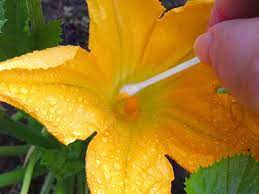Squash Anthers are a critical part of the flower’s reproductive system, specifically the male reproductive structures. They are located within the flower and are responsible for producing and storing pollen, which contains the male gametes (sperm cells) necessary for fertilization.
The anther is typically a bilobed structure found at the top of the stamen, which is the male reproductive organ of a flower. Each lobe of the anther contains pollen sacs called microsporangia. These sacs produce microspores through a process called microsporogenesis. These microspores then develop into pollen grains through the process of microgametogenesis.
“Squash” in the context of studying anthers refers to a technique used to prepare anther tissue for microscopic examination. This technique involves placing a small portion of anther tissue on a microscope slide, adding a drop of a suitable liquid (often a staining solution or a clearing agent), and gently pressing a coverslip over the tissue to flatten it. This allows for a clear view of the anther’s internal structures under a microscope.
The progression of microspores into mature pollen grains, each of which contains the male gametes. The anatomy and organization of tissues within the anther, including the different cell types and layers. Determining if the pollen grains are mature and viable for fertilization. Squashing anthers is a fundamental technique in botany that helps researchers understand the reproductive processes in plants and plays a vital role in studying plant development, genetics, and evolution.
The Economic Importance and Uses of Squash Anthers
Squash anthers, specifically referring to the male reproductive parts of the squash plant, have several economic and practical uses, particularly in the field of agriculture and plant breeding.
Here are the key economic importance and uses of squash anthers:
1. Plant Breeding and Hybridization: Squash anthers are crucial in the process of plant breeding and hybridization. Breeders use anthers to cross-pollinate different squash varieties, aiming to develop new hybrid varieties with desirable traits such as disease resistance, higher yield, improved taste, or longer shelf life.
2. Genetic Diversity and Improvement: By collecting anthers from various squash plants, breeders can study the genetic diversity within a population. This understanding allows for the selection and breeding of plants with superior traits, contributing to the overall improvement of the squash crop.
3. Trait Selection and Modification: Anthers contain genetic material (pollen) that carries specific traits. By carefully selecting and modifying the anthers or using them in controlled pollination, breeders can achieve desired traits in the resulting squash plants, enhancing characteristics such as color, size, texture, and nutritional content.
4. Crop Improvement for Abiotic and Biotic Stress Resistance: Squash anthers play a significant role in breeding for stress-resistant varieties, such as resistance to drought, pests, diseases, and adverse environmental conditions. This is vital for ensuring sustainable and robust crop production.
5. Accelerated Breeding Programs: The use of squash anthers can accelerate the plant breeding process. By carefully selecting and cross-breeding anthers, breeders can develop improved squash varieties within a shorter time frame, leading to faster commercialization and availability of new, superior squash cultivars.
6. Market Demand and Consumer Preferences: Meeting the demands of consumers who prefer specific squash characteristics, such as taste, appearance, or nutritional content, is a key economic advantage. Squash anthers help breeders create squash varieties that align with consumer preferences, potentially boosting market demand and profitability.
7. Export Opportunities: Developing squash varieties with enhanced attributes can open up new export opportunities. Countries can export improved squash varieties to meet the preferences of international markets, contributing to economic growth through trade and commerce.
Read Also: 24 Medicinal Health Benefits Of Pulsatilla chinensis (Chinese Pasque Flower)
8. Research and Education: Squash anthers are essential for research and educational purposes. Scientists use anthers to study genetics, reproductive biology, and other aspects of plant science. This knowledge helps inform breeding strategies, optimize crop production, and educate future generations of agronomists and plant scientists.
The Products and By-products That Can Be Derived From Squash Anthers
Squash anthers are a part of the male reproductive structure in squash plants. While they primarily contain pollen, they can also yield some useful products and by-products. Here are the main ones:
1. Pollen: Pollen is the primary product derived from squash anthers. It contains the male gametes necessary for plant reproduction. Pollen can be used in various ways, including plant breeding, hybridization, and genetic research.
2. Pollen Extracts: Pollen extracts can be prepared from the pollen collected from squash anthers. These extracts can be used in nutritional supplements, as they may contain proteins, amino acids, vitamins, and minerals.
3. Allergenic Extracts: Some individuals may have allergies to pollen. Allergenic extracts can be prepared from squash pollen and used for diagnostic and therapeutic purposes to treat allergies through immunotherapy.
4. Medicinal Compounds: Squash pollen may contain bioactive compounds with potential medicinal properties. Research is ongoing to explore these compounds for their potential in treating various health conditions.
5. Cosmetic and Beauty Products: Some beauty and cosmetic products use pollen or pollen extracts for their potential skin-nourishing and antioxidant properties.
6. Fertilizers: Pollen, rich in nutrients, can be used as a natural fertilizer to enhance plant growth and development in gardens or agricultural fields.
7. Animal Feed: Squash pollen can be utilized as a supplemental feed for animals, providing them with essential nutrients.
8. Bee Food: Pollen is a critical food source for bees. Beekeepers may use squash anther pollen to supplement bee diets, promoting healthy bee populations and enhancing honey production.
9. Research and Education: Squash anthers and the pollen they contain are essential in various scientific research, genetic studies, and educational purposes, helping researchers and students understand plant reproduction and genetics.
In conclusion, squash anthers are valuable in plant breeding, genetics, and crop improvement, ultimately leading to the development of better squash varieties with enhanced traits and economic benefits for farmers, producers, and consumers alike.
Read Also: Best Wood Waste Management Practices

